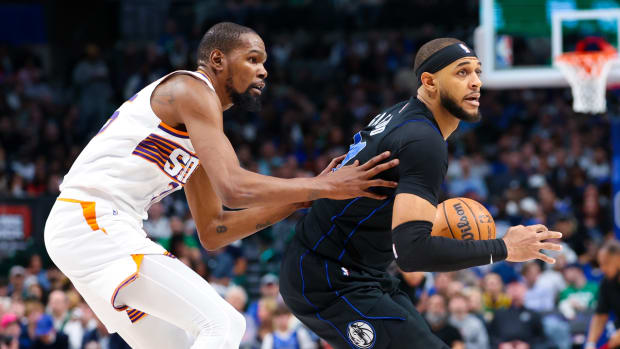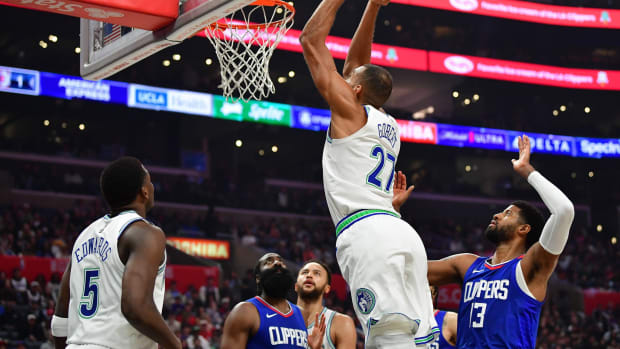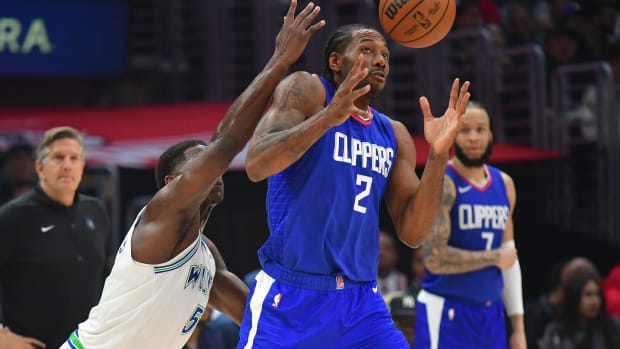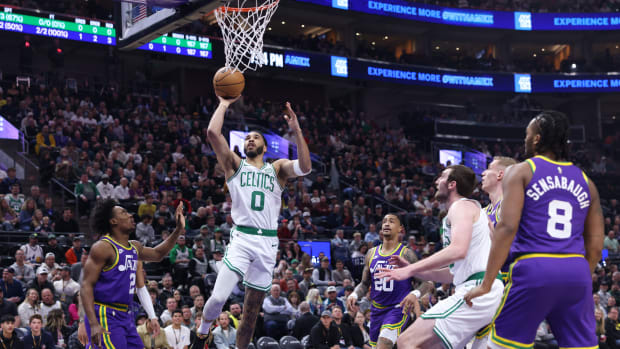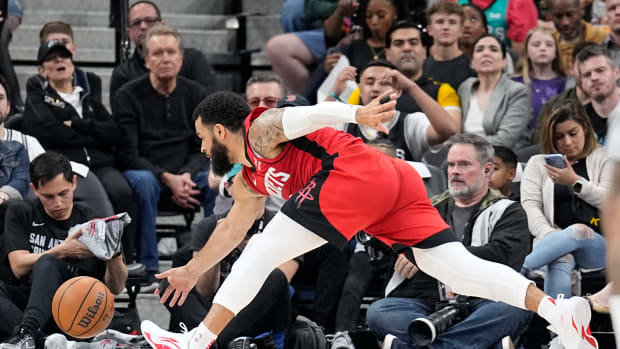SI:AM | There’s No Coming Back From the T-Wolves’ Epic Collapse
Good morning, I’m Dan Gartland. The Grizzlies are showing championship-caliber resilience.
In today’s SI:AM …
📈 One of the biggest playoff comebacks ever
If you’re reading this on SI.com, you can sign up to get this free newsletter in your inbox each weekday at SI.com/newsletters.
Minnesota can’t recover from this
It looked for a while last night like the Grizzlies, the No. 2 seed in the Western Conference, were in pretty serious trouble. Then the comeback began.
Early in the second quarter, the Timberwolves led by 26 points, but Memphis closed the quarter on a run to bring the halftime deficit to seven. Minnesota responded after the break and extended the lead back to 25 points with 3:10 left in the third quarter. That’s when the wheels fell off for the T-Wolves.
Over the final 15 minutes, the Grizzlies outscored Minnesota 50–16, including a 21–0 run, and won the game, 104–95, to take a 2–1 series lead. When the Grizz took the lead at 86–85 on a Tyus Jones three with 7:09 left to play, it was the only lead change of the game.
The 26-point comeback is tied for the fourth-largest in NBA playoff history and is one of just 32 games in NBA regular-season and postseason history in which a team dug out of that big a hole. It was tied for the largest comeback in Grizzlies team history.
The thing about the comeback that should have other teams scared is that Memphis surged back without much help from its star players. Ja Morant, Desmond Bane and Jaren Jackson Jr. were quiet in the second half, combining for just 24 of Memphis’s 60 points, while Jones, Brandon Clarke and Dillon Brooks added 32.
It’s hard to see how Minnesota can rebound from such a demoralizing loss. The Timberwolves capitalized on their emotional win in the play-in tournament and rode that momentum to a victory over the Grizz in Game 1, but Memphis dominated in a 124–96 win in Game 2 and reasserted its superiority in last night’s game. The Grizzlies are a far better team, and they’ve proved it in convincing fashion in the last two games. Turning things around in Game 4 tomorrow will be a challenge for the Timberwolves, and if they can’t, there’s a good chance the series ends in Memphis on Tuesday.
But it might not be all doom and gloom, according to SI’s Michael Pina. For long stretches of the game (and the season), Minnesota showed its defensive strength:
“During the regular season, the Timberwolves led the NBA in points off turnovers and were second in opposing turnover rate. They finished third in deflections per game and third in loose balls recovered. With an aggressive pick-and-roll strategy that forces the ball to fly through a thicket of moving arms. In Game 3, Memphis’s turnover rate was 18.6%, a mark they topped only four times all season.”
If that effort and intensity carries over to Game 4 and beyond, Pina writes, the T-Wolves aren’t out of this thing. But, if their offense gets forced into consistently creating in the half court, it could look a lot like Game 2 and the final 15 minutes of Game 3.
The best of Sports Illustrated
In today’s Daily Cover, Howard Megdal explains how Brittney Griner’s detention in Russia has impacted the entire WNBA:
“Amid all this turmoil and global tragedy, the general belief among players, executives and agents alike is that the WNBA, strangely, has an opportunity. The optics of players going to earn their real money overseas (at the expense of staying in the public eye Stateside) have long nettled league executives who, in the most recent collective bargaining agreement, won new strictures on international play. Players, meanwhile, have long been frustrated that the WNBA doesn’t pay them enough to justify staying at home in the offseason. Now, with the Russian and Chinese leagues out of play and the WNBA riding a new financial high, the league has a chance to show players it can be their exclusive basketball home.”
Jay Wright’s retirement leaves men’s college basketball with one less influential leader, Kevin Sweeney writes. … Chris Mannix writes that the Nets “are in a world of trouble” as they attempt to dig out of a 2–0 hole against the Celtics. … These are the six teams most likely to land Deebo Samuel, according to Conor Orr. … Emma Baccellieri wrote about the way milestone chases warp our perception of baseball after the Yankees denied Miguel Cabrera a chance to pick up his 3,000th hit in memorable fashion.
Around the Sports World
Devin Booker is now reportedly expected to miss two to three weeks with his hamstring injury. … The Bucks’ Khris Middleton will miss the rest of the series against the Bulls with a knee injury. … Ben Simmons is reportedly aiming to make his season debut in Game 4 against the Celtics. … Canadiens great Guy Lafleur has died. … Mike Tyson was involved in an altercation with a passenger on a plane. … Two Double A teams were involved in an ugly benches-clearing brawl. … Trevor Bauer’s administrative leave has been extended through April 29.
The top five...
… things I saw yesterday:
5. Ja Morant’s tweet after the Grizzlies’ win
4. Spencer Dinwiddie’s dunk on Rudy Gobert
3. Tigers fans chanting “Yankees suck” after they walked Miguel Cabrera
2. Bryan Reynolds’s heads-up baserunning to stretch a weak grounder into a triple
1. This fan at the A’s-Orioles game very nonchalantly catching a foul ball
SIQ
Cabrera, one of the greatest hitters of his generation, is on the cusp of joining the 3,000-hit club. When he does so (he’s sitting at 2,999 right now after getting intentionally walked in his final plate appearance against the Yankees yesterday afternoon), he’ll become just the seventh player in major league history to tally 500 home runs and 3,000 hits. How many others in that group can you name? (Hint: only four have more than 600 home runs.)
Yesterday’s SIQ: Who did the Mets trade Philip Humber (who threw a perfect game on April 21, 2012) for in ’08?
Answer: Johan Santana. The Twins also got Carlos Gomez, Kevin Mulvey and Deolis Guerra.
Humber struggled early in his pro career. After a decent season in 2006, his second year in the minors, he made two brief relief outings for the Mets as a September call-up. He got called up again in September ’07, and the reeling Mets pressed him into action in the final week of the season to start against the Nationals. He allowed five runs over four innings as the Mets suffered another loss on their way to blowing a seven-game lead in the division. He was traded to the Twins after the season.
Humber didn’t fare much better in Minnesota. He made 13 appearances in 2008 and ‘09, all in relief, recording a 6.10 ERA in 20 2/3 innings. He became a free agent after the ’09 season and signed a minor league deal with the Royals, making eight appearances in the big leagues for Kansas City before he was released in the offseason.
He was well on his way to becoming a bust when he landed with the White Sox in 2011. At 28, Humber finally had his first full season as an MLB starter, recording a 3.75 ERA in 26 starts. He carried that momentum into the ’12 season, allowing just one run in his first start of the year.
On April 21, 2012, in the 30th start of Humber’s MLB career, he retired 27 Mariners in a row, striking out Brendan Ryan for the final out. (Fans in Seattle got to witness another perfect game, thrown by Félix Hernández, later that season, the first time two perfect games had been thrown in the same park in the same season.)
Humber’s career unraveled quickly after the perfect game. He allowed nine runs in his next start and eight runs two starts after that. He missed about a month’s worth of games in June and July with an elbow injury. After giving up six runs on 10 hits on Aug. 3, he was removed from the starting rotation.
The White Sox waived Humber after the season, and he was picked up by the Astros. He made 17 appearances (seven starts) for Houston, pitching to a 7.90 ERA. He spent 2014 with the A’s Triple A affiliate and pitched in Korea and the Dominican Republic before retiring in ’16.
Humber’s career wasn’t what he or the Mets envisioned when he was taken near the top of the draft in 2004, but for one afternoon in April ’12, he was perfect.
From the Vault: April 20, 1964
Rarely is a sporting event defined so clearly by the loser rather than by the winner. But the 1996 Masters was all about the man who lost—Greg Norman.
I wrote yesterday about Jack Nicklaus’s improbable win at the 1986 Masters, where Norman finished in a tie for second after a bogey on the final hole. Norman’s career was defined by near misses at majors. He finished in a tie for second at Augusta in ’87, too (after Larry Mize’s 140-foot chip-in on the second hole of a sudden-death playoff), tied for fifth in ’88 and tied for third in ’89 and ’95. He was second-best at the U.S. Open in ’84 and ’95 and at the PGA Championship in ’86 and ’93. He won the Open Championship in ’86 and ’93, but a major on U.S. soil proved to be elusive.
The 1996 Masters looked different, though. Norman came out hot in the first round, tying Nick Price’s course record with a 9-under 63. He was 3-under on Friday and 1-under on Saturday, putting him at 13-under through 54 holes, six shots clear of Nick Faldo in second place.
And then everything fell apart.
Norman crumbled in the final round, shooting a 6-over 78, while Faldo, his playing partner, shot a 5-under 67.
Norman could have shot a pedestrian round of even-par and still put on the green jacket. Instead, Norman found the water twice on the back nine (on the 12th and 16th) and allowed Faldo to win comfortably.
The splashdown on 12 came after Norman had seen his lead erased by three straight bogies and sat tied with Faldo at 9-under. After his tee shot on the par-3 landed in the water, Norman made a double bogey and was two shots behind Faldo. His tee shot on the par-3 16th also landed in the water and Norman made another double bogey, putting him four shots behind Faldo and effectively ending his chances of winning.
Here is how Rick Reilly described the scene in that week’s Sports Illustrated:
“The last 20 minutes were unlike any seen in the previous 59 Masters. Norman became a kind of dead man walking, four shots behind and all his dreams drowning in Augusta National ponds behind him. Spectators actually looked down, hoping not to make eye contact, as Norman passed among them on his way to the 18th tee. At the finish, as Faldo made a meaningless 15-foot birdie putt, the champion was unsure how to handle it. He barely raised his hands above his head, and he didn’t yell or dance. He looked like a man in the back of church who had won a clandestine hand of gin. After he finally took the accomplice ball out of the cup, he turned to Norman, hugged him long and hard and said, ‘I don’t know what to say. I just want to give you a hug. I feel horrible about what happened. I’m so sorry.’ Both men teared up.”
Check out more of SI’s archives and historic images at vault.si.com.
Editors’ note, April 22 at 1:23 p.m. ET: An earlier version of this story misspelled the name of the late Guy Lafleur. His name is spelled Lafleur, not LaFleur.































